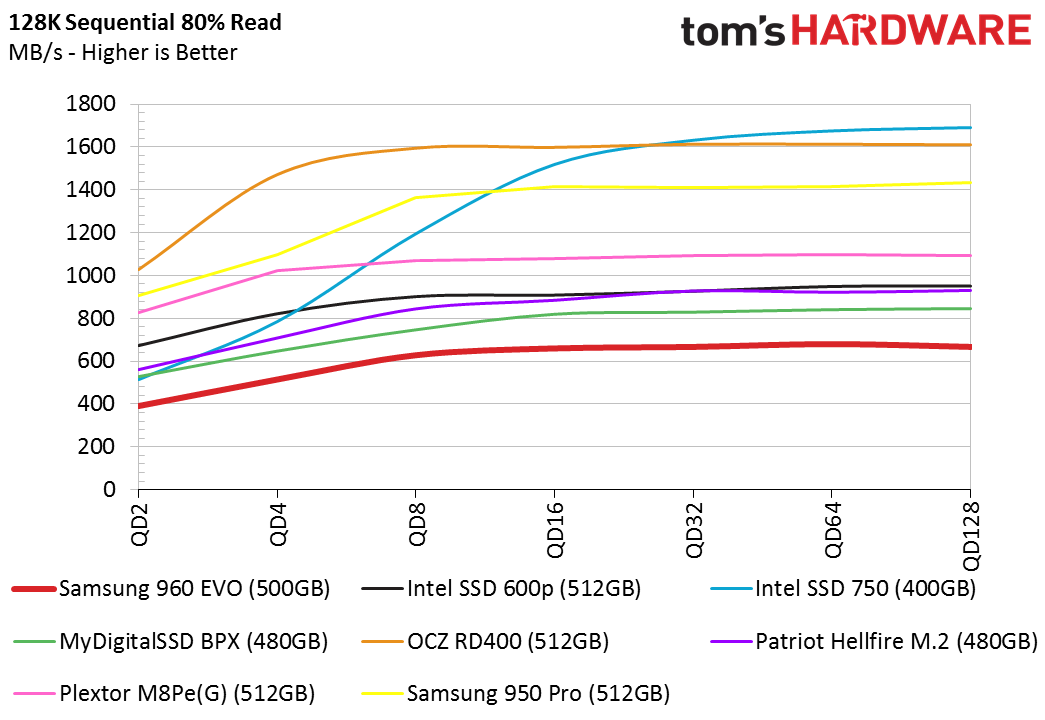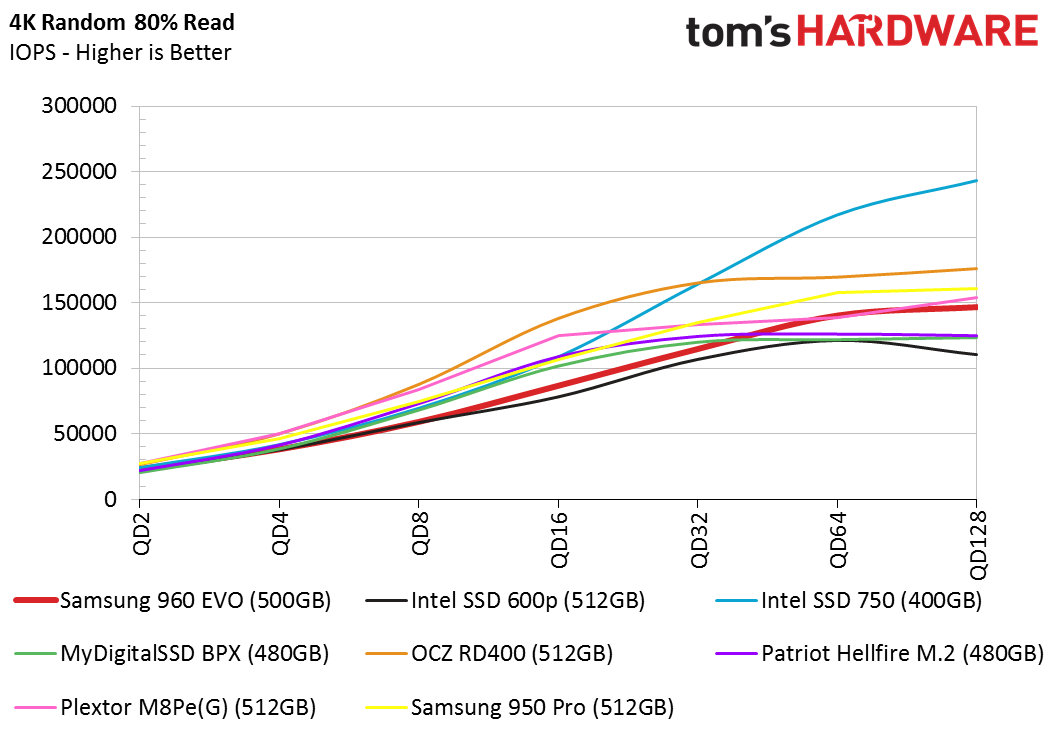Samsung 960 EVO NVMe SSD Review
Why you can trust Tom's Hardware
500GB Benchmark Results
Comparison Products
512GB NVMe SSDs offer a desirable price point, which starts as low as $170 and extends to $340, that can be difficult to turn away from. Oddly enough, Intel has both the lowest (600p 512GB) and highest (750 400GB) priced models. The 960 EVO 500GB slots in the middle price range and retails for as low as $250 at the time of writing.
Sequential Read Performance
To read about our storage tests in-depth, please check out How We Test HDDs And SSDs. We cover four-corner testing on page six of our How We Test guide.


The Samsung 960 EVO 500GB delivers exceptional low-QD sequential read performance thanks to the company's advanced 3D V-NAND flash. The 960 EVO outperforms the other drives at QD1, and trails only the 950 Pro 512GB at QD2. The drive scales well to QD8, but performance begins to trail off past that mark as the latency begins to stack up behind the queued commands.
Sequential Write Performance


TurboWrite technology, Samsung's name for programmed SLC cache, helps the 960 EVO deliver the highest sequential write speed at QD1 and QD2. Performance drops off due to the cache fill and flush procedure at higher queue depths, but most users will stay in the QD1 to QD4 range most of the time.
Random Read Performance



Even with TLC V-NAND, the 960 EVO delivers the highest random read performance at QD1. This follows a long line of EVO series products that top this particular test. The EVO retains its lead until reaching a plateau at QD16, which is well outside of the envelope of normal consumer workloads.
Random Write Performance
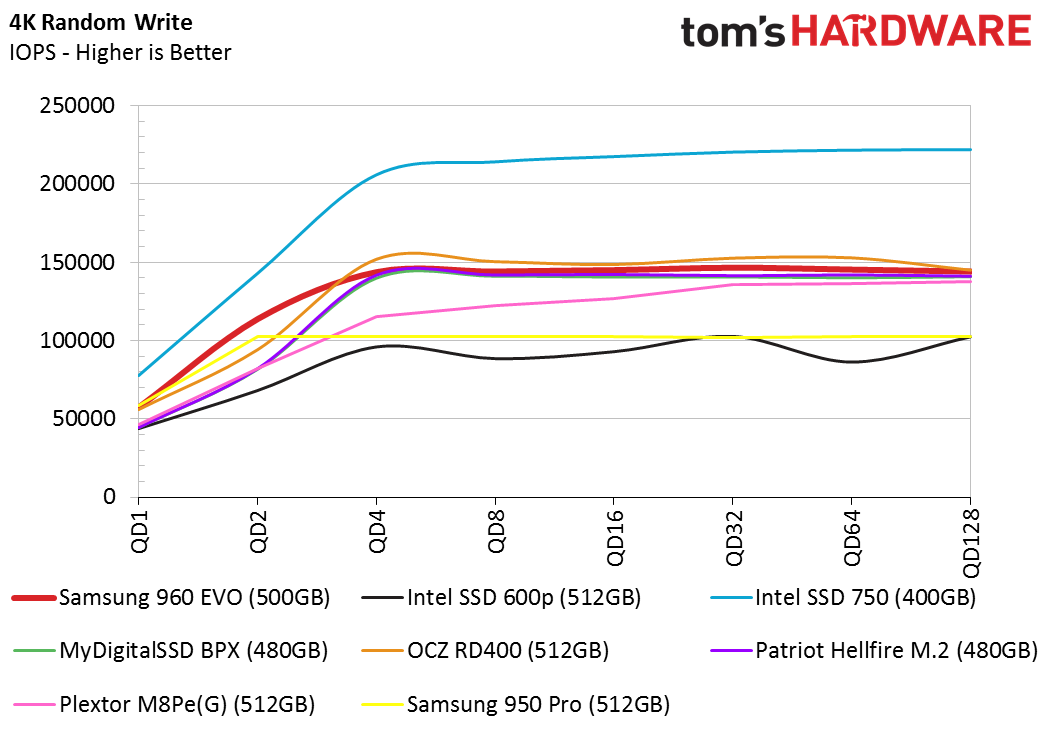


The EVO doesn't outright win the 4K random write test, but it lands in the top three for most of the low queue depth ranges.
80 Percent Sequential Mixed Workload
We describe our mixed workload testing in detail here and describe our steady state tests here.
Get Tom's Hardware's best news and in-depth reviews, straight to your inbox.
The mixed sequential results caught us by surprise. We expected the 5-core Polaris controller to perform better with TLC V-NAND in this test, but the 960 EVO 500GB delivered the lowest result of the test pool. We suspect this will shine through in our real-world application tests.
80 Percent Random Mixed Workload
The 960 EVO 500GB fared slightly better in the mixed random test with an 80% read workload. The drive is still at the bottom end of the performance scale, and this will affect real-world workloads. Most of the host system background read and write activity is small randomly-accessed logging and metadata files.
Sequential Steady-State



The Samsung EVO series has historically been the only high-performance product to ship with TLC flash. Its high status falls off, just like its performance, in a steady-state condition. The SLC buffer fails to keep performance high during this punishing workload like it does during consumer workloads. The chart shows that under heavy write workloads the 960 EVO can't keep pace with many of the other consumer NVMe SSDs with MLC. The EVO does perform much better than the Intel 600p, which is the only other drive in our test pool with TLC NAND. On the other end of the scale, the 960 EVO outperforms only the TLC-based 600p during a steady state 70% and 80% read workload.
Random Steady-State


One thing is for certain, Samsung's V-NAND flash and powerful controller combinations can sustain performance even under difficult conditions. The 960 EVO 500GB delivers higher random write performance than the 950 Pro 512GB that came to market last year. The Intel SSD 750 400GB delivers higher performance, but it comes with more deviation (which appear as peaks and valleys) compared to the two Samsung SSDs on the chart. The Plextor M8Pe(G) in an M.2 form factor with a thin aluminum heatsink also delivers true consistency and quite a bit more performance than the EVO 500GB. Both products would deliver a positive user experience in a consumer RAID 0 array on an Intel motherboard.
PCMark 8 Real-World Software Performance
For details on our real-world software performance testing, please click here.



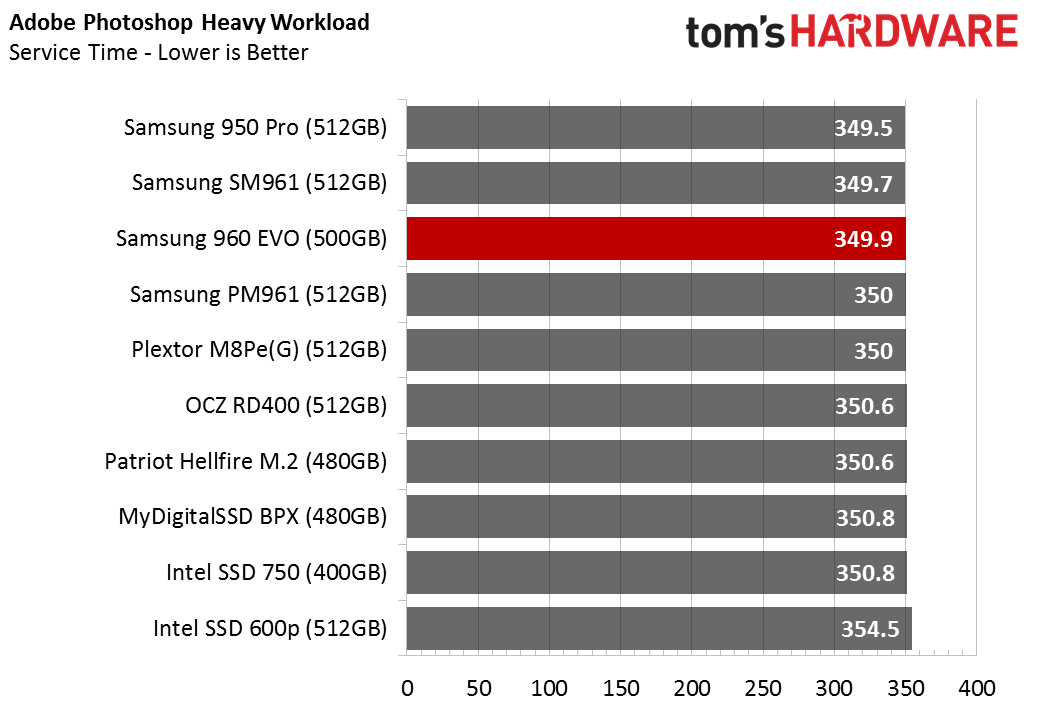

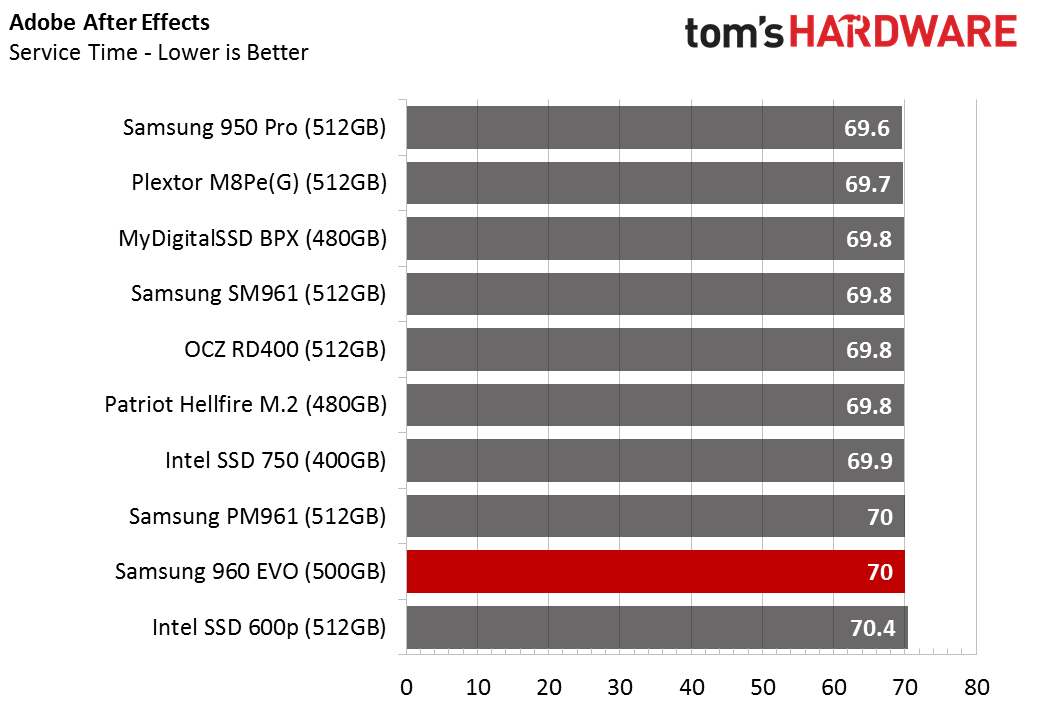




The low mixed workload performance comes to light during our real-world application tests. The EVO series generally outperforms every other consumer SATA SSD in these focused tests. NVMe opens a wider channel for the data to flow, and that actually hurts the EVO series when it goes against MLC-based products. The other products have caught up to Samsung's TLC V-NAND performance advantage.
Application Storage Bandwidth
In this chart, we take the same data and average the results to present an easy to read throughput rating. The test reveals that many of the new NVMe products offer similar performance. It also reveals that our PM961 SSD that we purchased to sneak an early look at the 960 EVO was very close to the final retail product.
PCMark 8 Advanced Workload Performance
To learn how we test advanced workload performance, please click here.



The Samsung 960 EVO 500GB recovers well after a stressful workload. This is another test where the SATA-powered EVO series dominated, but it falls to the middle of the pack behind the NVMe protocol. We focus primarily on the recovery phase. The recovery phase provides enough idle time to allow the drives to shuffle data and clear the NAND cells for fresh, incoming data.
Total Service Time

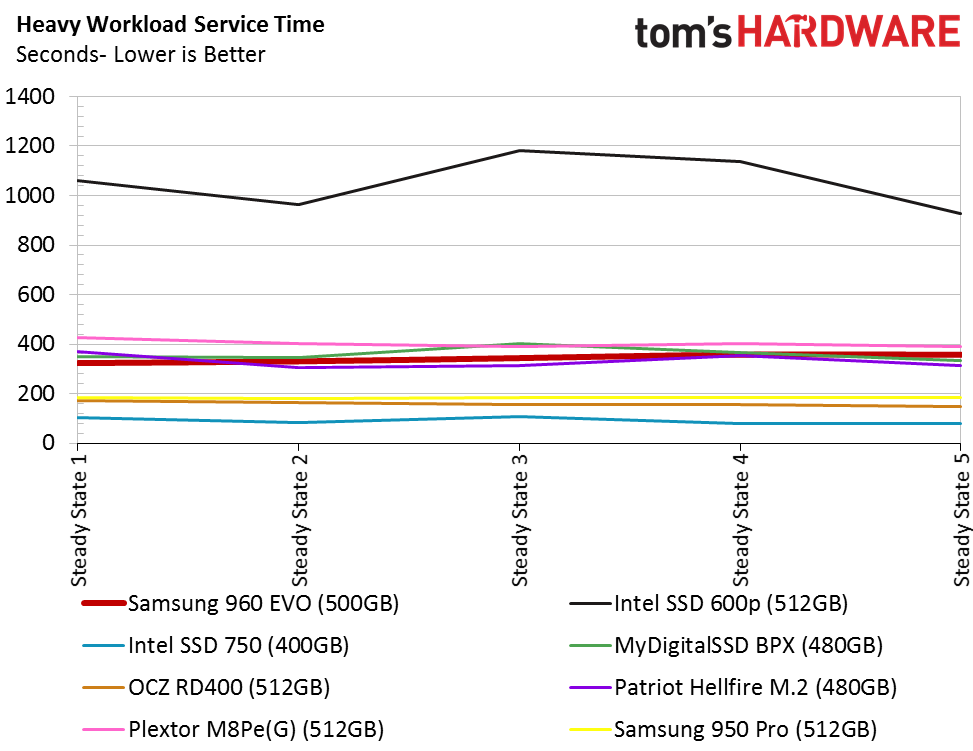

The Samsung 960 EVO 500GB is still a very powerful SSD, it just no longer sets the bar us to judge for other consumer SSDs against. Its dominance has passed, and a some next generation NVMe products, including the 950 EVO 500 GB, share the role.
Disk Busy Time
The disk busy time test measures how long the drive works to complete a given activity. This is different than both latency and throughput. This test is often associated with power consumption because it measures overall drive activity. Two different products can deliver the same throughput, but one may take longer to start a task while both finish in the same amount of time.
The 960 EVO requires more time to finish the tasks during the heavy workload than the 950 Pro and MyDigitalSSD BPX. Most of the products settle in the same range during the recovery phase, except for the Plextor M8Pe. The Plextor uses a unique wear-leveling algorithm that increases latency after a heavy workload.
Responsiveness Test


The Responsiveness Test comes from the latest iteration of BAPCo's SYSmark 2014. This specific portion of the test measures the storage system's responsiveness or latency. There is also a power measurement option with the use of a special meter. We use Lenovo Y700-17 notebooks in this test, just like the Notebook Battery Life test that also uses BAPCo software.
BAPCo records a measurement that serves as a base score of 1000. BAPCo uses an OEM Samsung SSD with planar (2D) TLC NAND flash (the retail equivalent is a Samsung 750 series SSD) as the reference drive. A score of 2,000 would represent a 100% increase in responsiveness or, stated conversely, a 200% latency decrease. For reference, a Seagate Laptop HDD 2TB scores 723 in the responsiveness test and a Western Digital Slim 1TB scores 755. The Samsung 850 EVO 500GB, a SATA-based SSD, scores 1,020, which is the highest score we've recorded for a SATA SSD.
Notebook Battery Life


We learned during the Samsung 960 Pro review that Samsung's new NVMe 2.0 driver reduces notebook battery life in our test with BAPCo's MobileMark 2014.5. The driver increases system performance, but it comes at the expense of battery life. The two are often related and work against each other because higher performance usually requires more power.
The 960 series is a departure from what we've come to expect from the Samsung SSDs that often dominate the power efficiency chart. Over time, we may see NVMe drivers that target different environments. Companies could release a desktop driver that focuses on high performance, and a notebook driver that focuses on increased efficiency. If any company were to kick off the trend, it would be Samsung, largely because the company has the resources to invest in the technology. Many of the products in the test still use the in-box Microsoft driver that ships with modern versions of Windows. The Microsoft NVMe driver is a balanced catchall that works for both desktops and notebooks, but it doesn't favor one over the other.
Current page: 500GB Benchmark Results
Prev Page 1TB NVMe SSD Performance Results Next Page 250GB Benchmark Results
Chris Ramseyer was a senior contributing editor for Tom's Hardware. He tested and reviewed consumer storage.
-
shrapnel_indie While I agree power hungry SSDs are problematic in the mobile sector, they are usually not a problem in the desktop sector (other than potential heating issues which exist for any market.)Reply
Glad to see Samsung finally have working parts to show off though. While taking time to make sure its good, is good, it isn't so good if price/performance isn't. However, since it is a Samsung, people will buy... and that could hurt if it actually fails expectations. (Remember the 840 EVO issues that left a bad taste in the mouth of some.) -
logainofhades For that price, they can keep them. Can get a 1.1tb MX300, for a similar cost to that 500gb 960 evo.Reply -
2Be_or_Not2Be Reply18870825 said:For that price, they can keep them. Can get a 1.1tb MX300, for a similar cost to that 500gb 960 evo.
However, the MX300 consistently is a worse performer than the 960 Pro/EVO. So I guess you have to weigh what's more important to you - better performance or the additional capacity. -
songer121 pre ordered the pro... cannot wait for that beast to come in. the speeds of those new 960's are crazy fastReply -
elbert The 250GB for $129 looks pretty sweet. I be picking one of those up in my build early next year.Reply -
logainofhades Just look at the application performance, which is more of a real world usage scenario.Reply
http://www.tomshardware.com/reviews/crucial-mx300-ssd-review,4723-3.html
vs
http://www.tomshardware.com/reviews/samsung-960-evo-nvme-ssd-review,4802-2.html
The worst benchmark was the heavy adobe workload. Still less than 10s, on the service time. Every other benchmark was a good deal closer than that. 10s is not worth double the cost.
-
Game256 Glad I decided not to wait for the reviews/release and bought SM961 for the same price as EVO.Reply
It's more risky, there is no official support, but the difference in performance turned out to be huge.
I don't agree with Chris that Samsung is not considering 250 Gb version to be bestselling drive.
It looks like they want to begin full transition to the NVMe SSDs with this exact model, because absolute majority of users can spend up to 150$ on the new drive, up to 180$ max (capacity doesn't matter). And Samsung even removed 256 Gb version of Samsung 960 PRO so that it doesn't interfere with this model.
Yes, the performance of 960 EVO is not so great, but pretty significant compared to SATA. And low price together with highly popular brand should do their job. -
sillynilly I will grab the 1Tb - will be my first one. I had lustily eyed the intel for quite some time, now I can finally grab something similar for more than half the price.Reply -
trifler After reading this article, I want to know how the 960 EVO compares with the 850 EVO at 250-256GB. Should I go ahead and get an 850 EVO then?Reply



